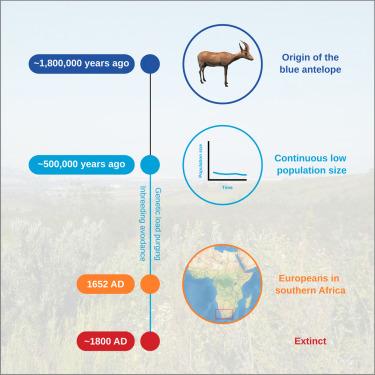Current Biology ( IF 9.2 ) Pub Date : 2024-04-12 , DOI: 10.1016/j.cub.2024.03.051 Elisabeth Hempel , J. Tyler Faith , Michaela Preick , Deon de Jager , Scott Barish , Stefanie Hartmann , José H. Grau , Yoshan Moodley , Gregory Gedman , Kathleen Morrill Pirovich , Faysal Bibi , Daniela C. Kalthoff , Sven Bocklandt , Ben Lamm , Love Dalén , Michael V. Westbury , Michael Hofreiter

|
Low genomic diversity is generally indicative of small population size and is considered detrimental by decreasing long-term adaptability.1,2,3,4,5,6 Moreover, small population size may promote gene flow with congeners and outbreeding depression.7,8,9,10,11,12,13 Here, we examine the connection between habitat availability, effective population size (Ne), and extinction by generating a 40× nuclear genome from the extinct blue antelope (Hippotragus leucophaeus). Historically endemic to the relatively small Cape Floristic Region in southernmost Africa,14,15 populations were thought to have expanded and contracted across glacial-interglacial cycles, tracking suitable habitat.16,17,18 However, we found long-term low Ne, unaffected by glacial cycles, suggesting persistence with low genomic diversity for many millennia prior to extinction in ∼AD 1800. A lack of inbreeding, alongside high levels of genetic purging, suggests adaptation to this long-term low Ne and that human impacts during the colonial era (e.g., hunting and landscape transformation), rather than longer-term ecological processes, were central to its extinction. Phylogenomic analyses uncovered gene flow between roan (H. equinus) and blue antelope, as well as between roan and sable antelope (H. niger), approximately at the time of divergence of blue and sable antelope (∼1.9 Ma). Finally, we identified the LYST and ASIP genes as candidates for the eponymous bluish pelt color of the blue antelope. Our results revise numerous aspects of our understanding of the interplay between genomic diversity and evolutionary history and provide the resources for uncovering the genetic basis of this extinct species’ unique traits.
中文翻译:

尽管基因组适应了低种群规模,但殖民导致的蓝羚羊灭绝
基因组多样性低通常表明种群规模小,并且被认为会降低长期适应性,因此是有害的。1 , 2 , 3 , 4 , 5 , 6此外,较小的种群规模可能会促进同系物的基因流动和近交抑制。7 , 8 , 9 , 10 , 11 , 12 , 13在这里,我们通过从已灭绝的蓝羚羊 ( Hippotragus leucophaeus ) 中生成 40 倍核基因组来检查栖息地可用性、有效种群规模 ( Ne ) 和灭绝之间的关系。历史上,非洲最南部相对较小的开普植物区14、15种群被认为是在冰期-间冰期周期中扩张和收缩的,追踪合适的栖息地。16 , 17 , 18然而,我们发现长期的低N e,不受冰川周期的影响,这表明在大约公元 1800 年灭绝之前,低基因组多样性持续了数千年。缺乏近亲繁殖,以及高水平的基因清除,表明对这种长期低N e的适应以及殖民时代人类的影响(例如狩猎和景观改造),而不是长期的生态过程,是其灭绝的核心。系统发育基因组分析揭示了马毛羚( H. maquinus)和蓝羚羊之间,以及马毛羚和黑貂羚羊(H. niger )之间的基因流,大约在蓝羚羊和黑貂羚羊分化的时间(∼1.9 Ma)。最后,我们确定了LYST和ASIP基因作为蓝羚羊同名蓝色皮毛颜色的候选基因。我们的结果修正了我们对基因组多样性和进化历史之间相互作用的理解的许多方面,并为揭示这种灭绝物种独特性状的遗传基础提供了资源。



























 京公网安备 11010802027423号
京公网安备 11010802027423号